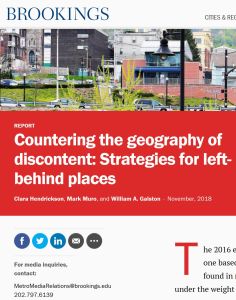Rejoignez getAbstract pour lire le résumé !

Rejoignez getAbstract pour lire le résumé !
Clara Hendrickson, Mark Muro and William A. Galston
Countering the Geography of Discontent
Strategies for Left-Behind Places
Brookings Institution, 2018
Aperçu
A set of new federal policies can counteract America’s growing geographic economic divide.
Recommendation
The election of Donald J. Trump to the US presidency in 2016 highlighted the stark cultural and economic disparities between small-town, rural America and the country’s thriving, cosmopolitan urban centers. These new social and economic realities result from long-term economic trends instigated by the digital revolution, a group of Brookings Institution scholars explains. The authors outline a set of federal economic policies that can help left-behind regions catch up. This eye-opening and well-written report will be of interest to policy makers, political activists and anybody concerned about the rise of populist discontent.
Summary
About the Authors
Clara Hendrickson, Mark Muro, and William A. Galston are researchers at the Brookings Institution in Washington, DC.

























Comment on this summary